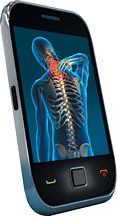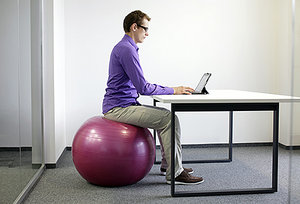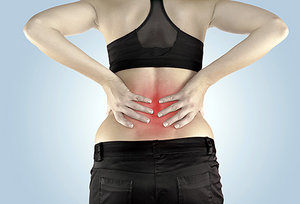PAIN is a significant problem in our society, and
the way too many of us deal with it, either by taking medication to
temporarily relieve the pain or ignoring the pain altogether, foolishly
hoping it will go away, is an even bigger problem, contributing to
long-term disability and reduced quality of life. Here are a few
important pieces to the puzzle that can help you deal with pain now and
prevent future episodes - chronic pain- from ruining your life.
How
do you feel at this very moment? You can do a easy self-check just by
moving your neck, shoulders, arms and legs around. Do you have any aches
and pains anywhere? If your response is, "Don't most people have pain
somewhere in their body?" or "Doesn't pain come with old age?" keep in
mind that while that's true, it doesn't mean you have to accept it. And
remember, pain isn't just physical. The emotional stress it creates can
be as hard on you as the pain itself. Let's talk about ways you can find
relief from your physical pain, which will undoubtedly lighten your
emotional load at the same time.
Pain Defined
 Pain
Pain is defined as an unpleasant sensation that can range from
mild, localized discomfort to sheer agony. Pain has physical and
emotional components. The physical part of pain results from nerves
being stimulated. Pain may be confined to a specific area, as in an
injury, or it can be spread throughout the body. Around the world,
millions of people live with pain in some form or another, involving
many different body parts, on a daily basis.
One of the most
interesting things about pain is how each human being deals with it.
Some learn to live with pain. Others can't stand to feel even an ounce
of it. The most common types of pain include arthritis, lower back,
bone/joint pain, muscle pain and
fibromyalgia
(widespread pain, tenderness and fatigue in muscles,tendons and
ligaments). Back pain is the most frequent cause of limited activities
for people younger than 45 years old.
Acute vs. Chronic Pain
Acute pain
is a normal sensation triggered in the nervous system to alert you to
possible injury and the need to take care of yourself. This type of pain
comes on quickly and can be severe, but it lasts a relatively short
period of time. In general, acute pain is in response to an event that
happens to the body. It may be a result of surgery or an accident.
Chronic pain
is different. Chronic pain tends to stay around or progress over longer
periods of time. Pain signals keep firing in the nervous system for
weeks, months or even years. Oftentimes, chronic pain is resistant to
traditional medical treatments. The emotional component of pain often
comes into play in a chronic situation.
The Consequences of Pain
The
loss of productivity and daily activity due to pain is substantial.
Americans spend at least $50 billion per year on back pain, and that's
just for the more easily identified costs. Pain has a negative impact on
an individual's quality of life. It diminishes one's ability to
concentrate, do their job, exercise, socialize, perform daily tasks and
sleep. Over time, this can lead to depression, isolation and loss of
self-esteem. Researchers have found that depression is the most frequent
psychological reaction to chronic pain.
If you hurt an area
of your body and do not restore proper, healthy movement patterns, you
will end up with problems later down the road. I can't tell you how many
patients I have seen who got in car accidents and hurt their neck and
back, but waited to get treatment and used pain as the indicator for how
they feel. Eventually, the pain went down or even away, but they were
often left with problems in their bones and joints.
Common Causes and Sources of Chronic Pain
An
initial injury like a trauma, fracture, sprain/strain, or serious
infection may be the cause of the chronic pain. There could also be an
ongoing cause like arthritis, cancer, an ear infection or injuries that
never healed properly. Some people even suffer chronic pain in the
absence of any past injury or evidence of body damage. Many chronic pain
conditions affect older adults. Common chronic pain complaints include
headache, low back pain, cancer pain, arthritis pain, neurogenic pain
(pain resulting from damage to the peripheral nerves or to the central
nervous system itself), and psychogenic pain (pain not due to past
disease or injury or any visible sign of damage inside or outside the
nervous system).
Quite simply, pain can come from anywhere
in the body. The source can be the neck, shoulders, low back, hips and
everywhere else. Many times, the location of the pain depends on how the
injury happened. Perhaps someone injured their shoulder while throwing a
ball. Maybe someone sprained their ankle while running. How about the
person who falls down the stairs and hurts multiple parts of their body
simultaneously?
Solving the Chronic Pain Puzzle

Pain is a complex puzzle. For certain cases, it takes complex solutions
to help solve that puzzle. In some cases, the individual's pain is so
debilitating that it requires the use of X-rays or other special imaging
to visualize the problem that is occurring in the spine or extremities.
It may be appropriate to use any of the following: Chiropractic, acupuncture, nutritional supplementation,
massage/bodywork, yoga and psychological therapy. In some cases, it may
even require over-the-counter or prescription medication (although the
goal is to avoid relying on these because of the potential side
effects). But there are definitely things you can do that can help you
prevent and treat chronic pain. Let's explore these strategies that, as
you might have guessed, are all related to one another.
1. Posture: You have probably been told at different times of your life about
the importance of good posture.
"Sit up straight" or "don't slouch" are probably familiar phrases to
you. Proper posture is difficult to attain, so don't stress yourself out
about it. When you are sitting, put a rolled-up towel or sweatshirt in
the small of your back. Sit all the way back to the rear of the chair so
you feel the support in your back. When you stand, stand against the
wall or a post so you can maintain erect posture. It is important to
strengthen your core muscles, the muscles along the spine. Yoga, Pilates
or a specific workout program with weights will help you achieve this.
You may want to find a personal trainer to help you focus on specific
exercises to help you achieve your goals.
2. Balance:
As you develop strength, you begin to develop balance. Many of the
positions utilized in yoga, Pilates and weight training work
specifically on balance. Would you believe that
your feet also have a lot to do with balance?
The three arches you have in your feet must all be supported in order
for the rest of your body to have good support as well. If one or more
of the arches is flat, it can significantly affect the stress to your
joints and your ability to exercise efficiently. Ask your chiropractor
about analyzing your feet to see if you need arch supports.
3. Spinal Load and Stability:
Understanding how to exercise or perform any type of sporting activity
is crucial to your health. How many people do you know who lift weights
incorrectly? On a daily basis, I see patients who have hurt themselves
with physical activity. By being careful and doing your exercises
properly, you can reduce the amount of spinal load (stress) and
instability you create for your body. I cannot tell you how important it
is to make sure your feet and all of the joints above them are healthy
and moving properly. When your joints move well, you can perform
activities optimally and with minimal stress on your body.
4. Alignment:
Exercising makes your muscles stronger, which also helps maintain
structural and bony alignment. Chiropractic care is hopefully a regular
part of your life. Visits to your chiropractor at a frequency you both
find appropriate will help you maintain your alignment.
Keep
in mind that pain may be indicative of a serious underlying condition.
Always talk to your doctor about any pain you are experiencing,
particularly if it does not go away or worsens with time.
 The solution, if there is one, is to find ways to make your commutes as
short, stress-free and infrequent as possible. Here are a few
suggestions:
The solution, if there is one, is to find ways to make your commutes as
short, stress-free and infrequent as possible. Here are a few
suggestions:

















